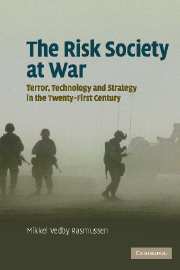Book contents
2 - Strategy, strategic studies and risk
Published online by Cambridge University Press: 22 September 2009
Summary
Strategy rationalises the use of armed force in order to identify the technologies, doctrines and agents that constitute a source of insecurity or a means for achieving security. This is not the way in which strategy is usually defined. There are, of course, many definitions of strategy, but most writers on the subject would probably agree that it is ‘a bridge between military means and political goals’. The bridge metaphor illustrates how the concept of strategy is a way of thinking about the connection between military means and political ends, but the history, as well as the future, of this way of thinking is as irrelevant for this kind of strategic analysis as the engineering of a bridge is to those who simply use it. However, there is a reason to take a closer look at ‘the bridge’ itself, because strategy is not merely a convenient term to describe the link between politics and military force. It was the concept of strategy, and the political and social conditions that created it, that established this link in the first place. The history of how military force came to be understood in terms of politics reveals that ‘strategy’ has been the conceptual switchyard by which the technologies, ideologies and social blueprints of modernity have been adopted in warfare. The definition adopted in this book on strategy has thus been calibrated as a way of studying strategy as a system of thought leading to action, rather than specific actions, as in standard definitions.
- Type
- Chapter
- Information
- The Risk Society at WarTerror, Technology and Strategy in the Twenty-First Century, pp. 12 - 42Publisher: Cambridge University PressPrint publication year: 2006



